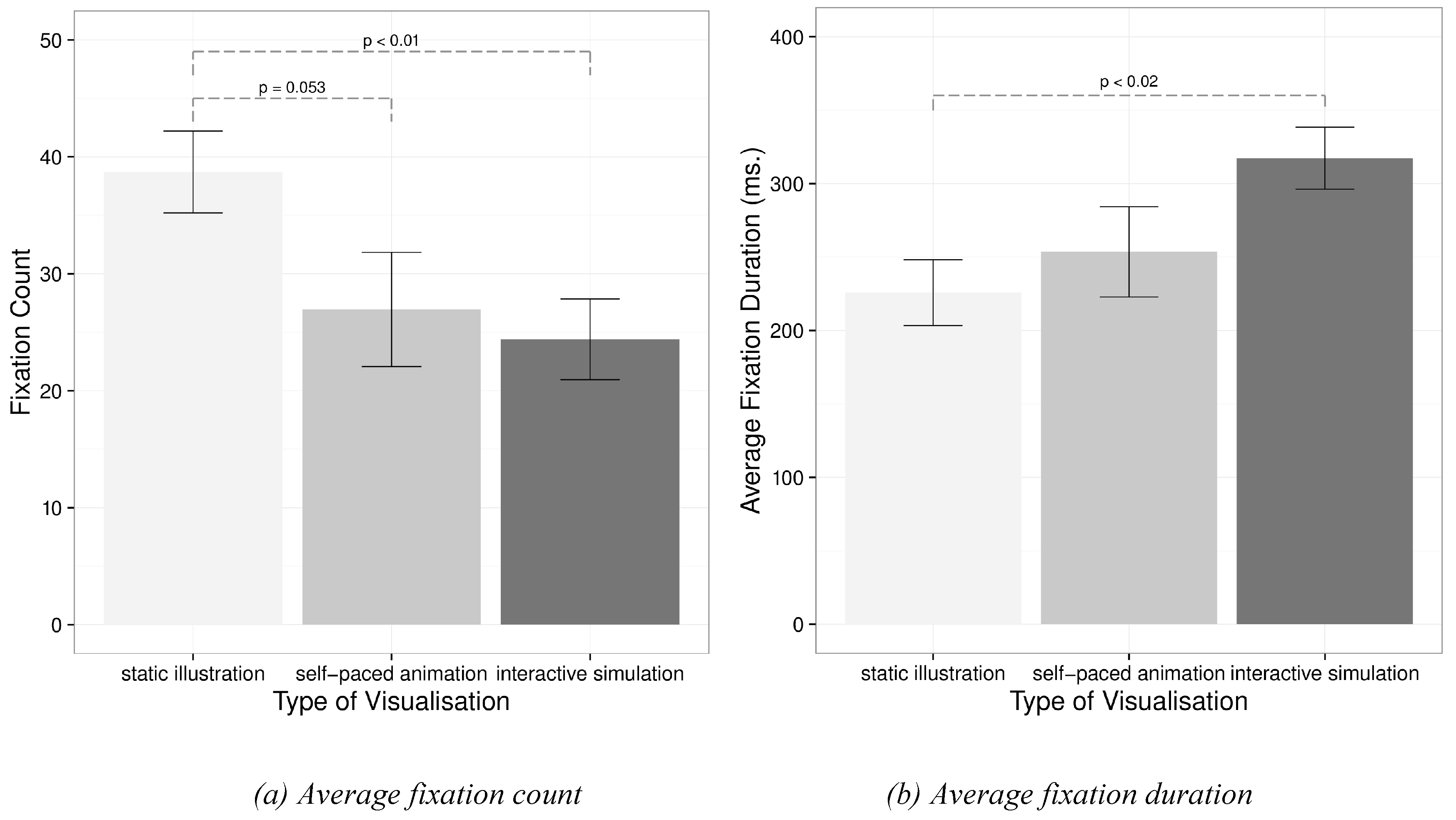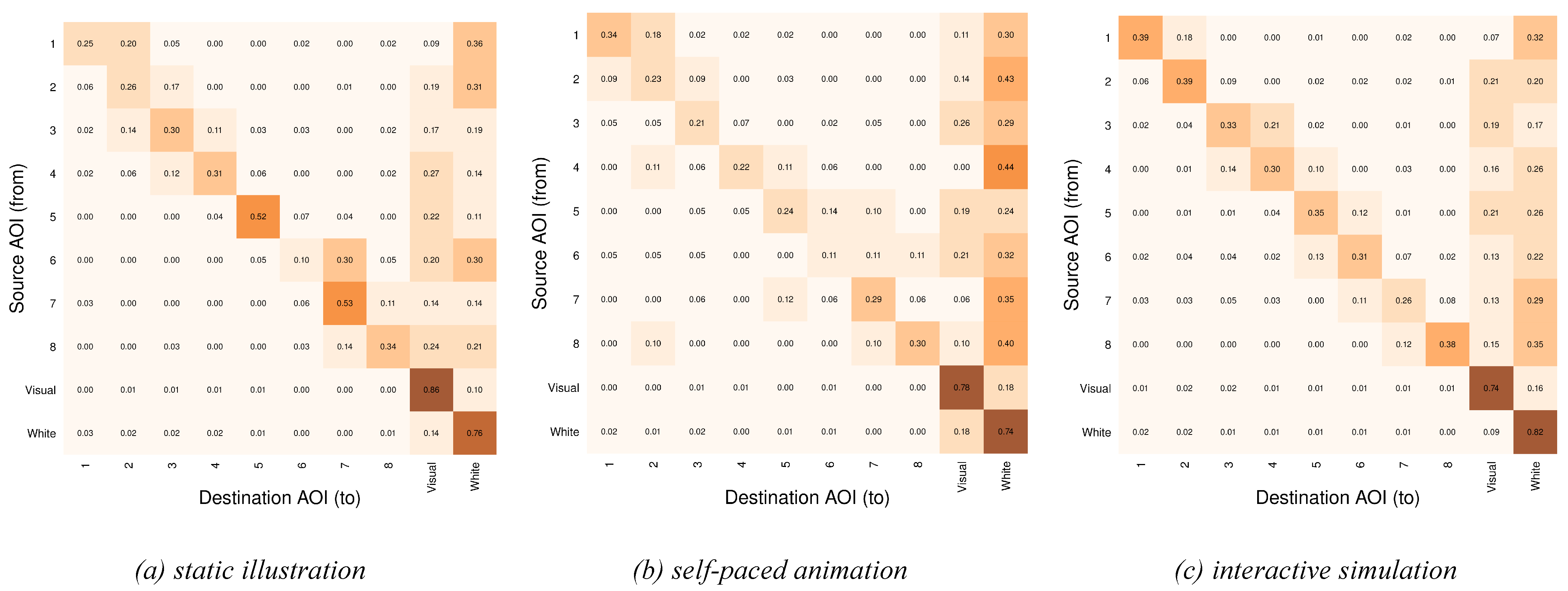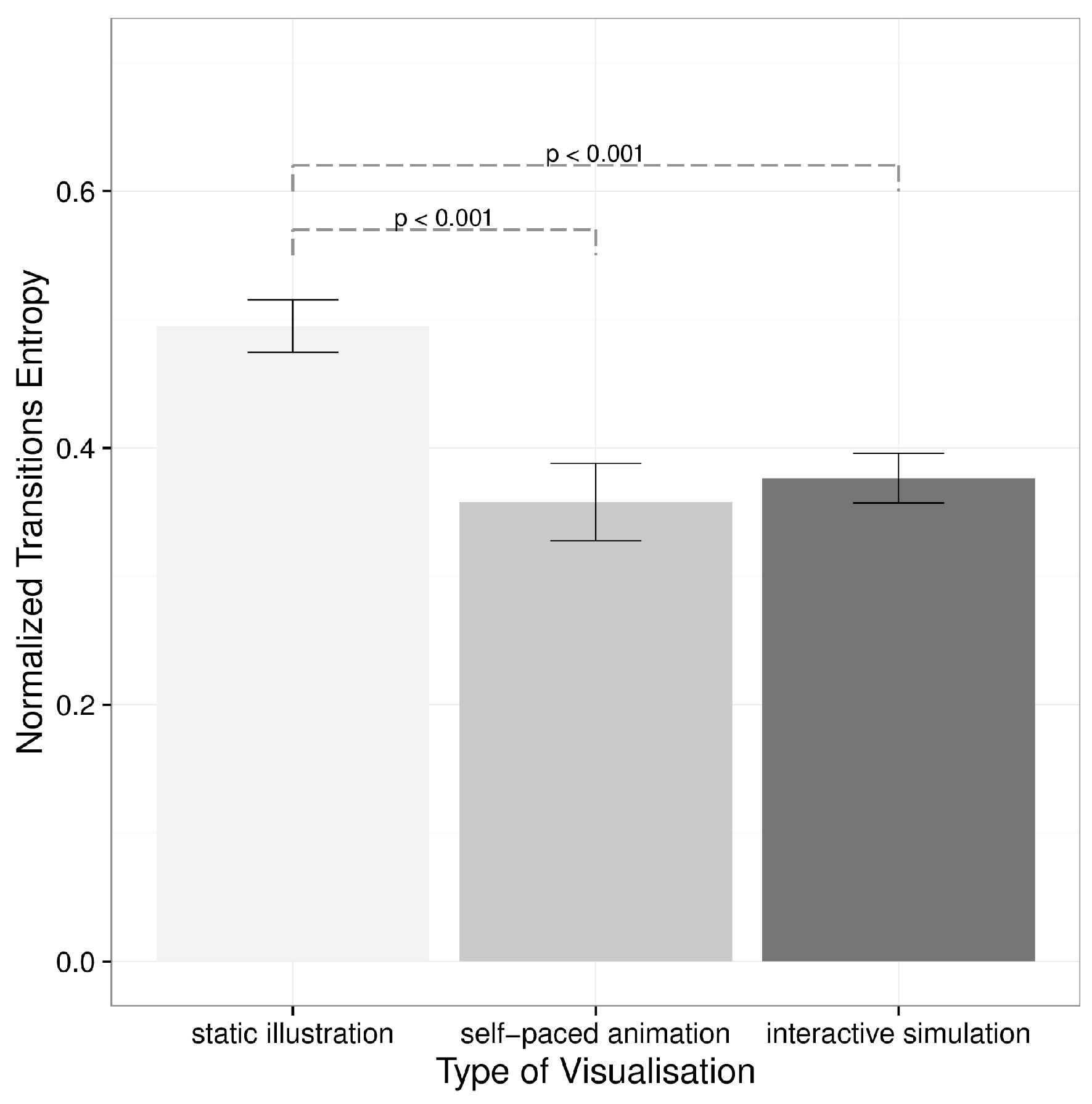Gaze Transitions when Learning with Multimedia
Abstract
:Introduction
Background
Scanpath Comparison
Interactive Multimedia Learning Materials
Impact of Working Memory Capacity
Hypotheses
Method
Participants
Stimuli and Procedure
- a static illustrated sequence of 7 consecutive snapshots for each move for n=3, see Figure 1(a);
- a self-paced animation, showing a visualization of continuous movements of 3 disks, which could be repeated on demand, see Figure 1(b); or
- an interactive simulation (also with 3 disks) allowing the user to manipulate the disks with the use of a mouse, see Figure 1(c).

Apparatus
Independent Variables
Dependent Variables

 , was calculated for normalized transition matrices. Empirical entropy
, was calculated for normalized transition matrices. Empirical entropy  was calculated individually for transition matrices for each participant allowing us to treat it as a dependent variable in the statistical analysis. For technical details, see Gaze Patterns and Transition Matrices in the Results. Low entropy values may be associated with higher predictability of eye movements (transitions between different AOIs) while high values of entropy indicate more random transition processes.
was calculated individually for transition matrices for each participant allowing us to treat it as a dependent variable in the statistical analysis. For technical details, see Gaze Patterns and Transition Matrices in the Results. Low entropy values may be associated with higher predictability of eye movements (transitions between different AOIs) while high values of entropy indicate more random transition processes.Results

Time to Complete Learning
Deeper Learning with Interactive Simulation?
Gaze Patterns and Transition Matrices
- reading the textual description and then focusingon the visualization,
- viewing the visualization and then reading the algorithm, or
- systematically switching gaze between the two ofthem.
Transition Matrix and Calculation of Entropy

 , an estimate of Shannon’s entropy, is defined as
, an estimate of Shannon’s entropy, is defined as
 was used. In line with predictions, multilevel linear models revealed that the type of visualization significantly predicted the empirical entropy of gaze transitions, χ2(2)=21.85, p<0.001, AIC=−13962.38, BIC=−13945.10. Participants exhibited more predictive (organized) patterns of gaze switching while learning with the interactive simulation (M=0.38, SE=0.02) compared to learning with the static illustration (M=0.49, SE=0.02), b=−0.12, t(36)=−4.20, p<0.001. Similarly, during learning with the self-paced animation, gaze transition patterns were also less random (M=0.36, SE=0.03) than in the static illustration condition, b=−0.14, t(36)=−3.77, p<0.001, see Figure 5.
was used. In line with predictions, multilevel linear models revealed that the type of visualization significantly predicted the empirical entropy of gaze transitions, χ2(2)=21.85, p<0.001, AIC=−13962.38, BIC=−13945.10. Participants exhibited more predictive (organized) patterns of gaze switching while learning with the interactive simulation (M=0.38, SE=0.02) compared to learning with the static illustration (M=0.49, SE=0.02), b=−0.12, t(36)=−4.20, p<0.001. Similarly, during learning with the self-paced animation, gaze transition patterns were also less random (M=0.36, SE=0.03) than in the static illustration condition, b=−0.14, t(36)=−3.77, p<0.001, see Figure 5. dependent on visualization type. The whiskers represents ±1SE.
dependent on visualization type. The whiskers represents ±1SE.
 dependent on visualization type. The whiskers represents ±1SE.
dependent on visualization type. The whiskers represents ±1SE.
Discussion
Study Limitations and Future Directions
Conclusions
Acknowledgments
References
- Acartürk, C., and C. Habel. 2012. Edited by R. Cox. Eye tracking in multimodal comprehension of graphs. In Tedr-2012: Proceedings of the workshop on technology-enhanced diagrams research. pp. 11–25. [Google Scholar]
- Andrade, J. 2001. Working memory in perspective. Hove: Psychology Press. [Google Scholar]
- Ashcraft, M., and E. Kirk. 2001. The relationships among working memory, math anxiety and performance. Journal of Experimental Psychology: General 2: 224–237. [Google Scholar] [CrossRef] [PubMed]
- Ayres, P., and F. Paas. 2007. Making Instructional Animations More Effective: A Cognitive Load Approach. Applied Cognitive Psychology 700, 21: 695–700. [Google Scholar] [CrossRef]
- Baddeley, A. 1986. Working memory. Oxford: Oxford University Press. [Google Scholar]
- Baddeley, A. 1999. Essentials of human memory. Boston, MA, USA: Hove: Psychology Press. [Google Scholar]
- Baddeley, A. 2000. The episodic buffer: A new component of working memory? Trends in Cognitive Sciences (4): 417–423. [Google Scholar] [CrossRef]
- Baddeley, A., S. Gathercole, and C. Papagno. 1998. The phonological loop as a language learning device. Psychological Review (105): 158–173. [Google Scholar] [CrossRef]
- Bednarik, R., and M. Tukiainen. 2008. Temporal eye-tracking data: Evolution of debugging strategies with multiple representations. In ETRA ’08: Proceedings of the 2008 Symposium on Eye Tracking Research & Applications. New York, NY, ACM: pp. 99–102. [Google Scholar]
- Bjork, R. 1994. Edited by J. Metcalfe and A. Shimamura. Memory and metamemory considering in the training of human beings. In Metacognition: Knowing about knowing. Cambridge, MA: MIT Press: pp. 185–205. [Google Scholar]
- Boucheix, J.-M., and R. K. Lowe. 2010. An eye tracking comparison of external pointing cues and internal continuous cues in learning with complex animations. Learning and Instruction 20, 2: 123–135. [Google Scholar] [CrossRef]
- Christiansen, S., E. Loftus, H. Hoffman, and G. Loftus. 1991. Eye Fixations and Memory for Emotional Events. Journal of Experimental Psychology: Learning, Memory, and Cognition 17: 693–701. [Google Scholar] [CrossRef]
- Conway, A. R. A., M. J. Kane, M. F. Bunting, D. Z. Hambrick, O. Wilhelm, and R. W. Engle. 2005. Working memory span tasks: A methodological review and user’s guide. Psychonomic Bulletin and Review 12: 769–786. [Google Scholar] [CrossRef] [PubMed]
- de Koning, B. B., H. K. Tabbers, R. M. J. P. Rikers, and F. Paas. 2010. Attention guidance in learning from a complex animation: Seeing is understanding? Learning and Instruction 20, 2: 111–122. [Google Scholar] [CrossRef]
- Di Nocera, F., M. Terenzi, and M. Camilli. 2006. Edited by D. de Waard, K. Brookhuis and A. Toffetti. Another look at scanpath: distance to nearest neighbor as a measure of mental workload. In Developments in Human Factors in Transportation, Design, and Evaluation. Maastricht, the Netherlands: Shaker Publishing: pp. 1–9. [Google Scholar]
- Duchowski, A. T. 2002. A Breadth-First Survey of Eye Tracking Applications. Behavior Research Methods, Instruments & Computers (BRMIC) 34, 4: 455–470. [Google Scholar]
- Dutke, S., and M. Rinck. 2006. Multimedia learning: Working memory and the learning of word and picture diagrams. Learning and Instruction (16): 526–537. [Google Scholar] [CrossRef]
- Eitel, A., K. Scheiter, A. Schüler, M. Nyström, and K. Holmqvist. 2013. How a picture facilitates the process of learning from text: Evidence for scaffolding. Learning and Instruction 28: 48–63. [Google Scholar] [CrossRef]
- Engle, R. W., and M. J. Kane. 2004. Edited by B. Ross. Executive attention, working memory capacity and a two-factor theory of cognitive control. In The Psychology of Learning and Motivation (Volume. Elsevier: vol. 44, pp. 145–199. [Google Scholar]
- Field, A., M. Jeremy, and F. Z. 2012. Discovering statistics using R. London, UK: SAGE Publications. [Google Scholar]
- Goldberg, J. H., and X. P. Kotval. 1999. Computer Interface Evaluation Using Eye Movements: Methods and Constructs. International Journal of Industrial Ergonomics 24: 631–645. [Google Scholar] [CrossRef]
- Graham, R. L., D. E. Knuth, and O. Patashnik. 1994. Concrete mathematics: A foundation for computer science, 2nd ed. Boston, MA, USA: Addison- Wesley Longman Publishing Co., Inc. [Google Scholar]
- Gyselinck, V., M.-F. Ehrlich, C. Cornoldi, R. de Beni, and V. Dubois. 2000. Visuospatial working memory in learning from multimedia systems. Journal of Computer Assisted Learning 16: 166–176. [Google Scholar] [CrossRef]
- Gyselinck, V., and C. Meneghetti. 2011. Edited by A. Van Dierendonck and A. Szmalec. The role of spatial working memory in understanding verbal descriptions: a window onto the interaction between verbal and spatial processing. In Spatial Working Memory. Psychology Press: pp. 159–180. [Google Scholar]
- Hegarty, M. 2004. Dynamic visualizations and learning: getting to the difficult questions. Learning and Instruction 14, 3: 343–351. [Google Scholar] [CrossRef]
- Henderson, J. M., and F. Ferreira. 1990. Effects of foveal processing difficulty on the perceptual span in reading: Implications for attention and eye movement control. Journal of Experimental Psychology: Learning, Memory, and Cognition 16, 3: 417–429. [Google Scholar] [CrossRef] [PubMed]
- Holsanova, J., N. Holmberg, and K. Holmqvist. 2009. Reading information graphics: The role of spatial contiguity and dual attentional guidance. Applied Cognitive Psychology 9, 29: 1215–1226. [Google Scholar] [CrossRef]
- Holzinger, A., M. Kickmeier-Rust, S. Wassertheurer, and M. Hessinger. 2009. Learning performance with interactive. simulations in medical education: Lessons learned from results of learning complex physiological models with the haemodynamics simulator. Computers and Education 2, 52: 292–301. [Google Scholar] [CrossRef]
- Hyönä, J. 2010. The use of eye movements in the study of multimedia learning. Learning and Instruction 20, 2: 172–176. [Google Scholar] [CrossRef]
- Jarodzka, H., K. Scheiter, P. Gerjets, and T. van Gog. 2010. In the eyes of the beholder: How experts and novices interpret dynamic stimuli. Learning and Instruction 20, 2: 146–154. [Google Scholar] [CrossRef]
- Jian, Y.-C., C.-J. Wu, and J.-H. Su. 2014. Learners’ eye movements during construction of mechanical kinematic representations from static diagrams. Learning and Instruction 32: 51–62. [Google Scholar] [CrossRef]
- Just, M. A., and P. A. Carpenter. 1980. A theory of reading: From eye fixations to comprehension. Psychological Review 87, 4: 329–354. [Google Scholar] [CrossRef] [PubMed]
- Krejtz, I., A. Szarkowska, K. Krejtz, A. Walczak, and A. Duchowski. 2012. Audio description as an aural guide of children’s visual attention: evidence from an eye-tracking study. In Proceedings of the symposium on eye tracking research and applications. pp. 99–106. [Google Scholar]
- Krejtz, K., A. Duchowski, T. Szmidt, I. Krejtz, F. González Perilli, A. Pires, A. Vilaro, and N. Villalobos. 2015. Gaze transition entropy. ACM Trans. Appl. Percept. 13, 1: 4:1–4:20. [Google Scholar]
- Krejtz, K., T. Szmidt, A. T. Duchowski, and I. Krejtz. 2014. Entropy-based Statistical Analysis of Eye Movement Transitions. In Proceedings of the 2014 Symposium on Eye-Tracking Research and Applications, New York, NY; ACM. [Google Scholar]
- Lowe, R., and J.-M. Boucheix. 2011. Cueing complex animations: Does direction of attention foster learning processes? Learning and Instruction 21, 5: 650–663. [Google Scholar] [CrossRef]
- Lusk, D. L., A. D. Evans, T. R. Jeffrey, K. R. Palmer, C. S. Wikstrom, and P. E. Doolittle. 2008. Multimedia learning and individual differences: Mediating the effects of working memory capacity with segmentation. British Journal of Educational Technology 40, 4: 636–651. [Google Scholar] [CrossRef]
- Marton, F., and R. Säljö. 1976. On qualitative differences in learning: 1. outcome and process. British Journal of Educational Technology 46: 4–11. [Google Scholar] [CrossRef]
- Mayer, R. E. 2002. Multimedia learning. Psychology of Learning and Motivation 41: 85–139. [Google Scholar]
- Mayer, R. E. 2010. Unique contributions of eye-tracking research to the study of learning with graphics. Learning and Instructions 20, 2: 167–171. [Google Scholar] [CrossRef]
- Meyer, K., T. Rasch, and W. Schnotz. 2010. Effects of animation’s speed of presentation on perceptual processing and learning. Learning and Instruction 20, 2: 136–145. [Google Scholar] [CrossRef]
- Moreno, R., and R. E. Mayer. 1999. Cognitive principles of multimedia learning: The role of modality and contiguity. Journal of Educational Psychology 91: 358–368. [Google Scholar] [CrossRef]
- Moreno, R., and R. E. Mayer. 2001. Virtual reality and learning: Cognitive and motivational effects of students’ sense of presence. In The Ninth International Conference on Human-Computer Interaction. pp. 65–67. [Google Scholar]
- Moreno, R., and R. E. Mayer. 2007. Interactive multimodal learning environments. Educational Psychology Review 19: 309–326. [Google Scholar] [CrossRef]
- Moreno, R., and A. Valdez. 2005. Cognitive load and learning effects of having students organize pictures and words in multimedia environments: The role of student interactivity and feedback. Educational Technology Research and Development 53: 35–45. [Google Scholar] [CrossRef]
- Nusir, S., I. Alsmadi, M. Al-Kabi, and F. Sharadgah. 2012. Studying the impact of using multimedia interactive programs at children ability to learn basic math skills. Acta Didactica Napocensia 2, 5: 17–31. [Google Scholar]
- Oberauer, K., H.-M. Süß, O. Wilhelm, and W. W. Wittman. 2003. The multiple faces of working memory: Storage, processing, supervision, and coordination. Intelligence 31, 2: 167–193. [Google Scholar] [CrossRef]
- Paas, F., P. Van Gerven, and P. Wouters. 2007. Instructional efficiency of animation: Effects of interactivity through mental reconstruction of static key frames. Applied Cognitive Psychology 21: 781–793. [Google Scholar] [CrossRef]
- Paik, E. S., and G. Schraw. 2013. Learning with Animation and Illusions of Understanding. Journal of Educational Psychology 105, 2: 278–289. [Google Scholar] [CrossRef]
- Ponsoda, V., D. Scott, and J. M. Findlay. 1995. A probability vector and transition matrix analysis of eye movements during visual search. Acta Psychologica 88: 167–185. [Google Scholar] [CrossRef] [PubMed]
- Possin, K. 2010. Visual spatial cognition in neurodegenerative disease. NEUROCASE 16: 466–487. [Google Scholar] [CrossRef] [PubMed]
- R Development Core Team. 2011. R: A Language and Environment for Statistical Computing [Computer software manual. Vienna, Austria. [Google Scholar]
- Rayner, K. 1978. Eye movements in reading and information processing. Psychological Bulletin 85: 618–660. [Google Scholar] [CrossRef]
- Rayner, K. 1998. Eye Movements in Reading and Information Processing: 20 years of Research. Psychological Bulletin 85: 618–660. [Google Scholar] [CrossRef]
- Rayner, K., and G. McConkie. 1976. What guides a reader’s eye movements. Vision Research 16: 829–837. [Google Scholar] [CrossRef]
- Rayner, K., A. Pollatsek, J. Ashby, and C. J. Clifton. 2012. Psychology of Reading, 2nd ed. New York, NY: Psychology Press. [Google Scholar]
- Richard, J.-F., S. Poitrenaud, and C. Tijus. 1993. ProblemSolving Restructurati: Elimination of Implicit Constraints. Cognitive Science 17: 497–529. [Google Scholar]
- Rosengrant, D. 2010. Gaze scribing in physics problem solving. In Proceedings of the 2010 symposium on eye tracking research & applications. New York, NY, ACM: pp. 45–48. [Google Scholar]
- Salvucci, D. D., and J. H. Goldberg. 2000. Identifying fixations and saccades in eye-tracking protocols. In Proceedings of the 2000 symposium on eye tracking research & applications. New York, NY, USA, ACM: pp. 71–78. [Google Scholar]
- Sanchez, C., and J. Wiley. 2006. An examination of the seductive details effect in terms of working memory capacity. Memory and Cognition 34, 2: 344–355. [Google Scholar] [CrossRef] [PubMed]
- Schmidt-Weigand, F., A. Kohnert, and U. Glowalla. 2010. A closer look at split visual attention in system-and self-paced instruction in multimedia learning. Learning and Instruction 20, 2: 100–110. [Google Scholar] [CrossRef]
- Schnotz, W., and M. Bannert. 2003. Construction and interference in learning from multiple representation. Learning and Instruction (13): 141–156. [Google Scholar] [CrossRef]
- Schnotz, W., and H. Horz. 2010. Edited by P. Peterson, E. Baker and B. McGaw. Technology and learning—support for skills learning. In International Encyclopedia of Education. Oxford and Elsevier: pp. 140–149. [Google Scholar]
- Schuler, A., K. Scheiter, and E. van Genuchten. 2011. The role of working memory in multimedia instruction: Is working memory working during learning from text and pictures? Educational Psychology Review 23, 3: 389–411. [Google Scholar] [CrossRef]
- Thurstone, L. 1938. Primary mental abilities. Chicago: University of Chicago Pres. [Google Scholar]
- Tijus, C., S. Poitrenaud, and J.-F. Richard. 2006. Human Problem Solving: Evidence for Contextual Categorization. In Information processing and management of uncertainty in knowledge-based systems. Paris, France: Editions EDK: pp. 1100–1109. [Google Scholar]
- Unsworth, N., and R. W. Engle. 2007. The nature of individual differences in working memory capacity: Active maintenance in primary memory and controlled search from secondary memory. Psychological Review 114: 104–132. [Google Scholar] [CrossRef]
- Van Meeuwen, L. W., H. Jarodzka, S. Brand-Gruwel, P. A. Kirschner, J. J. de Bock, and J. J. van Merriënboer. 2014. Identification of effective visual problem solving strategies in a complex visual domain. Learning and Instruction 32: 10–21. [Google Scholar] [CrossRef]
- Woods, D., M. M. Kishiyama, E. Yund, T. Herron, B. Edwards, O. Poliva, R.F. Hink, and B. Reed. 2011. Improving digit span assessment of short-term verbal memory. Journal od Clinical and Experimental Neuropsychology 33, 1: 101–111. [Google Scholar] [CrossRef]
- Yoon, D., and N. H. Narayanan. 2004. Mental imagery in problem solving: an eye tracking study. In Proceedings of the 2004 Symposium on Eye Tracking Research & Applications. New York, NY, ACM: pp. 77–84. [Google Scholar]
- Zanga, A., J.-F. Richard, and C. Tijus. 2004. Implicit learning in rule induction and problem solving. Thinking & Reasoning 10, 1: 55–83. [Google Scholar]
Copyright © 2016. This article is licensed under a Creative Commons Attribution 4.0 International License.
Share and Cite
Krejtz, K.; Duchowski, A.T.; Krejtz, I.; Kopacz, A.; Chrząstowski-Wachtel, P. Gaze Transitions when Learning with Multimedia. J. Eye Mov. Res. 2016, 9, 1-17. https://doi.org/10.16910/jemr.9.1.5
Krejtz K, Duchowski AT, Krejtz I, Kopacz A, Chrząstowski-Wachtel P. Gaze Transitions when Learning with Multimedia. Journal of Eye Movement Research. 2016; 9(1):1-17. https://doi.org/10.16910/jemr.9.1.5
Chicago/Turabian StyleKrejtz, Krzysztof, Andrew T. Duchowski, Izabela Krejtz, Agata Kopacz, and Piotr Chrząstowski-Wachtel. 2016. "Gaze Transitions when Learning with Multimedia" Journal of Eye Movement Research 9, no. 1: 1-17. https://doi.org/10.16910/jemr.9.1.5
APA StyleKrejtz, K., Duchowski, A. T., Krejtz, I., Kopacz, A., & Chrząstowski-Wachtel, P. (2016). Gaze Transitions when Learning with Multimedia. Journal of Eye Movement Research, 9(1), 1-17. https://doi.org/10.16910/jemr.9.1.5


